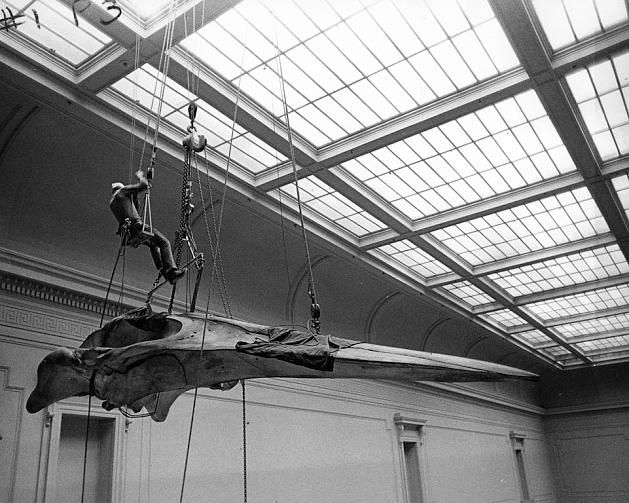When Did Today’s Whales Get So Big?
More recently than you might think, say scientists who scoured the fossil record
/https://tf-cmsv2-smithsonianmag-media.s3.amazonaws.com/filer/2f/1b/2f1b76d4-6fdd-469e-a1f7-3683bdb888e7/dsc_5195_edited_200.jpg)
When the dinosaurs fell, new giants emerged. From the African savannahs to the Australian outback, giant mammals that would have towered over their modern day descendants swiftly conquered nearly every continent. But in the ocean, whales took their time on the road to massiveness—and that slow expansion could explain why they’re still the biggest creatures around today.
That’s the conclusion of a new study by the Smithsonian’s Nicholas Pyenson and the University of California’s Geerat Vermeij, published July 5 in the journal Biology Letters. In the paper, Pyenson and Vermeij chronicle the rise in ocean giants over the last 34 million years, illuminating the markedly different evolutionary paths they took compared to their terrestrial counterparts.
“It’s such an obvious topic: When did giant whales come on the scene?” says Richard Norris, a paleobiologist at Scripps Institution of Oceanography who was not involved in the research. “For the most part that hasn’t been written about very much.” Perhaps it was just too obvious: It’s easy to assume that whales have always been large, whereas in reality whales historically were much smaller than the creatures we know today.
Spanning up to 100 feet and weighing up to 200 tons, the largest animal ever to have lived is one most people are familiar with: the formidable blue whale. The rest of the sub-order of baleen whales (or mysticetes) aren’t too shabby either, boasting some of the largest animals on our planet. But baleen whales didn’t start getting so huge until roughly 5.3 million years ago, at the transition of the Miocene into the Pliocene, according to the study. Meanwhile, the largest-ever land mammal—a relative of the rhino known as paraceratherium—achieved its gigantic size 30 million years ago.
“There’s something funny going on with whales that restricts them from accessing very large body sizes until basically a geological yesterday,” says Pyenson, a vertebrate paleontologist and curator of fossil marine mammals at the Smithsonian's National Museum of Natural History.
The inspiration for diving into the rise of marine giants came from a comparatively diminutive source. In 2012, Vermeij of the University of California, Davis showed that ancient mollusks had generally experienced a steady increase in body size as geological time progressed. Vermeij’s finding spurred a casual discussion with Pyenson (Vermeij was on Pyenson's dissertation committee, and the two had kept in touch) about whether similar trends could have occurred within other marine groups, which turned into a team effort to explore how body size evolved in marine mammals.

Pyenson dug through the mammal collection at the museum and off-site warehouses where the museum stores its larger whale fossils in an attempt to find the largest of them all. But he knew that a simple literature search, the common data sourcing technique in many papers, would be insufficient for finding the biggest of the big mammals. So he found each physical specimen, and measured the mammal skulls (a proxy for the animal’s body size) with calipers.
Most researchers agree that food source is a key factor in how big a consumer grows. Yet the giants of the ocean are not top predators. Rather, they feed on enormous amounts of small animals like krill—and the amount of krill available depends on the productivity of the ocean. Whales adapted very efficient filter feeding foraging techniques as early as the Oligocene, a time period that spans from 33.9 to 23 million years ago.
“That says something to me,” says Jeremy Goldbogen, a whale ecologist at Stanford University who was not involved in the research. “Something happened recently in the ocean that perhaps provided them with more food or different types of food resources. The next step will be to look where Pyenson shows this spike in gigantism to see what’s going on.”
Pyenson and Vermeij hypothesize that marine gigantism was set on a fast track because of a particularly productive ocean during the onset of the Pleistocene, roughly 2.5 million years ago. Giant ice sheets ground the earth into nutrient rich bits that found their way into the sea, potentially helping whales gain mass. Yet Norris’s research on oceanic productivity points to relatively productive oceans even earlier than when giant whales emerged. So why did they bulk up so late?
Perhaps, Norris says, it wasn’t just overall ocean productivity—but the distribution of that productivity. If food sources were far apart, it would help to be vast: a large body size not only helps you push through water more effectively, but also increases food storage for energy. “It strikes me that if you are a really big whale, you are big because you have to drive a long distance between food sources,” he says. Thus, “maybe that more modern, productive ocean is also a more patchy ocean.”
Studying the role of marine giants does more than fulfill a childlike curiosity about why things get big. From an ecosystem-wide perspective, big things matter: Despite their relative low abundance, large animals like whales, elephants, lions and sharks, have a disproportionate influence on their environment. (Elephants, for instance, fertilize important trees and disperse their seeds simply by pooping.)
As the climate changes, large marine mammals may be adversely affected—forcing them to move to different feeding grounds or even driving them to extinction. Without these pillars, ecosystems become dangerously unbalanced. “We are still struggling to understand what that means historically and going forward into the future,” says Pyenson. “Studying the history of big things in different climate settings—that’s going to be really important.”
(Editor's note: Danielle Hall is a writer at the Ocean Portal, part of the Smithsonian's National Museum of Natural History.)